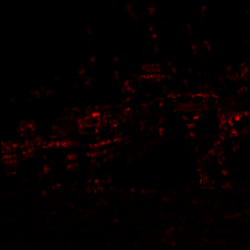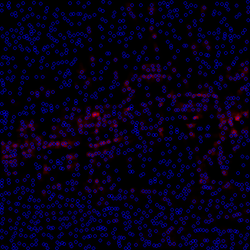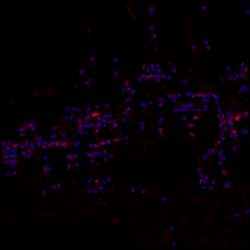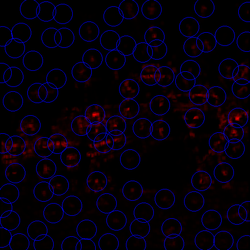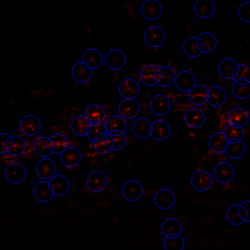Example Non Maximum Suppression
From BoofCV
Jump to navigationJump to search- Non-maximum suppression with different settings
Non-maximum suppression is a class of algorithm used to find local peaks and minimums inside a feature intensity image. This example demonstrations how to use efficient algorithms inside of BoofCV to quickly find extremes. Example Code:
Concepts:
- Feature detection
Related Examples:
Example Code
/**
* Non-maximum suppression is used to identify local maximums and/or minimums in an image feature intensity map. This
* is a common step in feature detection. BoofCV includes an implementation of non-maximum suppression which is much
* faster than the naive algorithm that is often used because of its ease of implementation. The following code
* demonstrates how some of the tuning parameters affects the final output.
*
* @author Peter Abeles
*/
public class ExampleNonMaximumSupression {
public static BufferedImage renderNonMax( GrayF32 intensity, int radius, float threshold ) {
// Create and configure the feature detector
NonMaxSuppression nonmax = FactoryFeatureExtractor.nonmax(new ConfigExtract(radius, threshold));
// We will only searching for the maximums. Other variants will look for minimums or will exclude previous
// candidate detections from being detected twice
QueueCorner maximums = new QueueCorner();
nonmax.process(intensity, null, null, null, maximums);
// Visualize the intensity image
BufferedImage output = new BufferedImage(intensity.width, intensity.height, BufferedImage.TYPE_INT_RGB);
VisualizeImageData.colorizeSign(intensity, output, -1);
// render each maximum with a circle
Graphics2D g2 = output.createGraphics();
g2.setColor(Color.blue);
for (int i = 0; i < maximums.size(); i++) {
Point2D_I16 c = maximums.get(i);
VisualizeFeatures.drawCircle(g2, c.x, c.y, radius);
}
return output;
}
public static void main( String[] args ) {
BufferedImage buffered = UtilImageIO.loadImageNotNull(UtilIO.pathExample("standard/boat.jpg"));
GrayF32 input = ConvertBufferedImage.convertFrom(buffered, (GrayF32)null);
// Compute the image gradient
GrayF32 derivX = input.createSameShape();
GrayF32 derivY = input.createSameShape();
GImageDerivativeOps.gradient(DerivativeType.SOBEL, input, derivX, derivY, BorderType.EXTENDED);
// From the gradient compute intensity of shi-tomasi features
GeneralFeatureIntensity<GrayF32, GrayF32> featureIntensity =
FactoryIntensityPoint.shiTomasi(3, false, GrayF32.class);
featureIntensity.process(input, derivX, derivY, null, null, null);
GrayF32 intensity = featureIntensity.getIntensity();
ListDisplayPanel panel = new ListDisplayPanel();
panel.addImage(buffered, "Input Image");
// hack to just show intensity - no features can be detected
panel.addImage(renderNonMax(intensity, 10, Float.MAX_VALUE), "Intensity Image");
// Detect maximums with different settings and visualize the results
panel.addImage(renderNonMax(intensity, 3, -Float.MAX_VALUE), "Radius 3");
panel.addImage(renderNonMax(intensity, 3, 30000), "Radius 3 threshold");
panel.addImage(renderNonMax(intensity, 20, -Float.MAX_VALUE), "Radius 10");
panel.addImage(renderNonMax(intensity, 20, 30000), "Radius 10 threshold");
ShowImages.showWindow(panel, "Non-Maximum Suppression", true);
}
}

